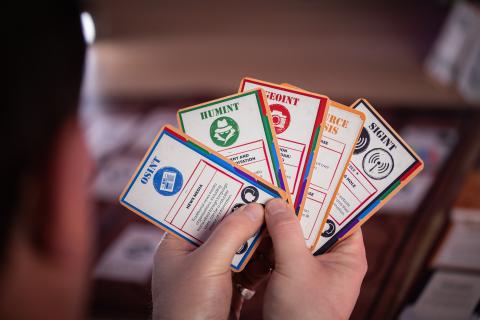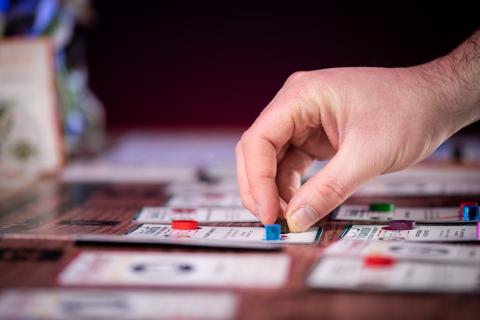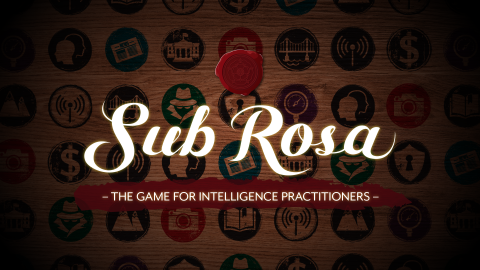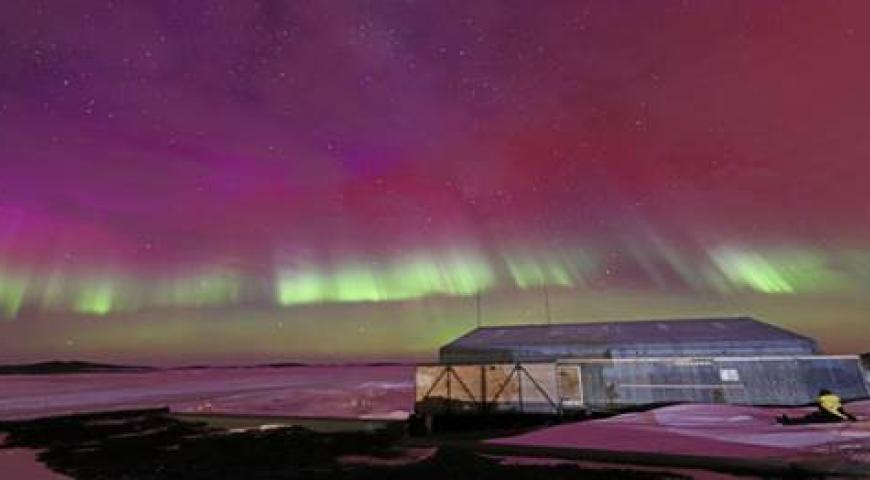Games allow you to get inside and operate the machine yourself and do experiments and pull a lever or push a button and see what happens. And because it's happening on the tabletop, rather than say, in a computer program, you, you can understand it very well. You can see exactly why what just happened. So, I became among others, a promulgator of, of that particular medium for teaching as well as for analysis.
From May 2022 to May 2023, I had the privilege of undertaking a secondment with the Strategic Gaming and Exercises (SGE) section in Futures Risk and Outreach branch of Strategic Policy Division. During this time, I developed a game designed to teach Defence intelligence graduates and new starters the intelligence cycle. The game is called Sub Rosa: The Game for Intelligence Practitioners.
Sub Rosa is a facilitated, competitive and cooperative board game where three to five players work to complete intelligence requirements against the triple adversaries of time, limited resources and changing priorities. This article documents my experiences developing Sub Rosa and provides insights that may be of use to other educational game designers. It also details the design choices made to improve the learning outcomes of the game, and the rationale behind them.
Why Gaming Matters
There is a significant amount of academic literature that supports the idea of games as an effective learning medium for most people. Games are often described as ‘fun’ events and, as noted by Wheaton, ‘fun translates into increased attention to the subject, and increased attention, in turn, facilitates learning’.[2]
In the military context, wargaming has been an integral, though not necessarily ‘fun,’ part of military planning across all domains. Examples of this range from the use of Kriegsspiel by the Prussian Army during the 19th century[3] through to the Center for the New American Century’s 2022 wargame series, Dangerous Straits: Wargaming a Future Conflict over Taiwan.[4]Wargames give planners the ability to ask the question ‘what if’ and test their assumptions in a safe-to-fail environment. Indeed, the Australian Army Wargaming Handbook states that wargaming is a ‘powerful tool capable of enhancing the cognitive capacity of our personnel and preparing them for joint force operations in a complex and rapidly evolving strategic environment. Wargaming is as relevant today as it was for the Prussians in the 1800s.’[5]
As a training tool, wargaming is invaluable for its ability to provide players with an experiential learning environment in which they are actively engaging with the subject matter at hand in an intellectual and in an often underappreciated, tactile manner. This training tool allows players to easily comprehend complex situations and appreciate how their decisions can affect success in the simulated environment. Furthermore, games force players to make decisions while accepting risk and the role of luck, and the need to adapt to changing environments. Indeed, as any gamer will mournfully admit, there is nothing more humbling then watching your cunning plan change from a ‘strategic masterpiece’ to ‘rank disaster’ upon the roll of a 1!
Recognising the importance of game-like environments for collaboration and learning, Strategic Policy Division of the Department of Defence maintains the directorate of Strategic Games and Exercises that ‘provides tailored design, development and delivery of strategic-level wargames and table top exercises, with a primary focus on policy and strategy issues’, and aims to ‘assist in promoting wargaming and analytical capabilities.’[6] It was into this team, and their environment that promoted the idea of learning through gaming, that I undertook a secondment that resulted in Sub Rosa.
Overview of Sub Rosa
Sub Rosa is a competitive and cooperative resource management game in which the players are members of the National Intelligence Community (NIC), making it their job to successfully respond to customer intelligence requirements. The game is modelled on the intelligence cycle as defined by ADF-P-2 Intelligence and each turn consists of the players moving through the cycle’s four phases–direction, collection, processing, and dissemination–to manage and meet the customer’s intelligence requirements and therefore retain their confidence and win the game.[7]

In Sub Rosa, the direction phase is when the government priority is determined, intelligence requirements are received, intelligence techniques and all-source analysis cards are allocated and a collection plan is developed and implemented. The last part of the phase is when a random event card injects a degree of (not necessarily wanted) reality into the turn.
During the collection-processing phase, players use their intelligence techniques cards to initiate collection against the appropriate intelligence requirement. Different Human Intelligence (HUMINT), Signals Intelligence (SIGINT), Geospatial Intelligence (GEOINT), Open-Source Intelligence (OSINT), and Measurement and Signature Intelligence (MASINT) collection techniques are available to the players and it is their job to manage the collection plan before time runs out for any specific intelligence requirement. Players are the Subject Matter Expert for one discipline each and they can use their expertise during this phase to initiate collection against intelligence requirements if nobody has an appropriate technique, though it does come at a cost.
The dissemination phase is the final phase of the game where customers prepare the intelligence requirements for submission to the customer, who will determine if their requirements have been met. This is explained in greater detail later in the article.
Conception
Early in my secondment, while discussing work options, I offhandedly suggested that I could develop a game that taught the intelligence cycle. The idea was accepted as a key project for my work focus and I spent much of the secondment developing Sub Rosa.
My sponsor for the project was AVM John McGarry, who had been through the game development process before when developing his games Contest in the South China Sea and Paradissio. His direction was that I was to develop an educational game that:
- familiarised Defence intelligence graduates and new starters with the intelligence cycle and the role they played within it
- discussed different intelligence sources and how they contributed to Defence intelligence
- demonstrated the interplay of different intelligence analytical and collection sources and agencies, including all-source agencies
- showed graduates and new starters what the Defence intelligence disciplines were, and how the graduates would contribute to Defence intelligence output, and
- could preferably be played at a classification no higher than PROTECTED.
With that initial direction, I began the daunting process of attempting to gamify a theoretical business model.
Imitation is the sincerest form of flattery
An initial problem was that I lacked game design experience, though I had played many miniatures-based games. Many books have been written on game mechanics and functions but they are difficult to decode if you lack experience with the game–akin to learning soccer from reading a book! One problem that had to be resolved early on was the type of game Sub Rosa should be. It quickly became clear that a competitive game was inappropriate because of both the sponsor’s direction and the fact that the NIC works collaboratively to produce intelligence. This meant that I needed to design a cooperative game to support the sponsor’s directives. One of the most popular cooperative games is Pandemic, and its key mechanic of a never-ending deluge of disease outbreaks inspired a similar approach for intelligence requirements in Sub Rosa.
Another problem was how to integrate the various intelligence collection disciplines undertaken throughout the intelligence cycle with the reality of limited resources and changing priorities. It was here that the CIA-developed card game Collection Deck proved to be another invaluable inspiration. In Sub Rosa, I took Collection Deck’s mechanic of multi-discipline problems and expanded it to better suit the learning outcomes of our intelligence world. I then added mechanics for changing government priorities, all-source analysis (see later), and random events.

The mechanics borrowed from other games ultimately saved me time, but they also provided well tested sub-routines that resulted in a deeper, more rounded game for Sub Rosa. Given its educational objective, it made sense to seek inspiration from the success of others and to build on known mechanics. This is how we ensure learning in our schools and universities, so it makes sense in game design.
More (to intelligence) than meets the eye
Throughout Sub Rosa’s development, I was reminded of the need to include an all-source analysis (ASA) mechanic, for there is much more to successful intelligence than the skills of the collection agencies. It is, after all, an intelligence community. However, figuring out how to show the benefit of all-source analysis was something that took some time to develop. Eventually I hit upon the idea of a card that was useful during the direction phase and during the dissemination phase of the game turn.
The first play of the ASA card in the direction phase represents the NIC’s agreement to prioritise, or at least deconflict, its resources against specific intelligence requirements. While this is important in the real world, it is the ASA’s second play that provides the most important learning outcome. When used during the dissemination phase, the ASA represents the collaborative analysis of all available intelligence and the preparation of an intelligence assessment product for the customer. Sub Rosa simulates the customer’s acceptance of an intelligence product with the roll of a die. While it is possible to meet customer requirements with less than complete collection or proper assessment, the die roll becomes progressively harder.

The ASA also became the mechanic that introduced player competition as players can earn individual points dependent on their ASA involvement. This point structure enabled me to give players a reason to act selfishly to compete for prestige and provided a way to immerse players in their role. It was also a way of demonstrating that intelligence agencies may unconsciously compete for, as well as cooperate on, intelligence delivery.
Not a spy game
One important fact about Sub Rosa is that it is an intelligence game, not a spy game. While there are numerous ‘spy’ games like Spy Alley, City of Spies: Estoril 1942, and Vienna Connection, these focus on HUMINT, and are often competitive in nature. Sub Rosa makes players take a step back from intelligence collection operations to get a holistic understanding of the practice of each step in the intelligence cycle and how it functions as part of the greater instrument of government. It demonstrates that no intelligence agency or individual exists in a vacuum, and that it is essential to understand that the customer is best served when all parts function cooperatively and collaboratively. This was a clear educational objective from the start and kept me from falling into a single discipline collection game.
Because of how it is played, Sub Rosa is a game that can be used by any organisation that uses multi-source analysed information as a way of understanding its operating environment. While Sub Rosa uses the intelligence cycle as it pertains to national security, it does not mean it cannot impart lessons to other organisations that use information and data in a similar way. An additional benefit of demonstrating the universality of the intelligence cycle is that is shows that intelligence is an integral and normal part of the policy development process and, collection techniques aside, not some rarefied realm operating outside of the requirements of the organisation it serves.
Conclusion
When developing a game, design choices are equally about the educational outcomes and the designer’s vision of the context in which the mechanics are engaged. For Sub Rosa, design choices such as making the game cooperative, incorporating a requirement for multi-disciplined collaboration, emphasising all-source assessments and avoiding the easy trap of a ‘spy game’ were crucial in ensuring that the game took the shape that it did. Some of these design choices were deliberate, whereas others came from sources of inspiration or an attempt to resolve incongruities in our model of how intelligence functions across the national security architecture. Regardless of origin, the design choices made reflect my attempt to square the circle of theory and practice. The process of game design is a rewarding one that I would encourage others to embark upon to create educational and entertaining ways of sharing professional knowledge.

If you would like to learn more about Sub Rosa: The Game for Intelligence Practitioners, please contact:
- spi-sp-fro-wge@dpe.protected.mil.au. ! Defence Restricted Network ONLY !
1 International Spy Museum (2022) So, I design board games for the CIA with Volko Ruhnke, SpyCast, Episode 530, 16 March, accessed 10 August 2023, <https://thecyberwire.com/podcasts/spycast/530/notes>.
2 Kristan J. Wheaton (2011) Teaching Strategic Intelligence Through Games, International Journal of Intelligence and CounterIntelligence, 24 (2): 367-382, doi:10.1080/08850607.2011.548217, accessed 07 August 2023, <https://doi.org/10.1080/08850607.2011.548217>.
3 International Kriegsspiel Society (2023) What is Kriegsspiel? accessed 23 May 2023, <https://kriegsspiel.org/what-is-kriegsspiel>.
4 Stacie Pettyjohn, Becca Wasser, and Chris Dougherty (2022) Dangerous Straits: Wargaming a Future Conflict over Taiwan, Center for a New American Century, June 15, accessed 07 August 2023, <https://www.cnas.org/publications/reports/dangerous-straits-wargaming-a-future-conflict-over-taiwans>.
5 Department of Defence (2022) Wargaming Handbook, Puckapunyal: Army Knowledge Centre, p. 12.
6 Department of Defence (2021) Military Strategy, May 12, accessed 07 August 2023, <http://drnet/strategy/OFASSP/militarystrategybranch/Pages/Military-Strategy-Branch.aspx>
7 The collection and processing phases had to be combined into one in the game. Department of Defence (2021), ADF Philosophical Doctrine 2 Series Intelligence, 4th Edition, Chapter 4, accessed 08 August 2023, < https://objective/id:G3224265 >. ! Defence Restricted Network ONLY !
Defence Mastery
Please let us know if you have discovered an issue with the content on this page.
Comments
Start the conversation by sharing your thoughts! Please login to comment. If you don't yet have an account registration is quick and easy.




